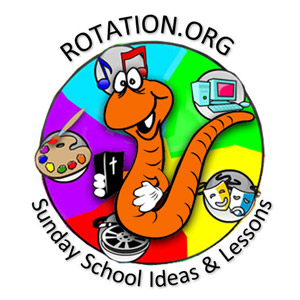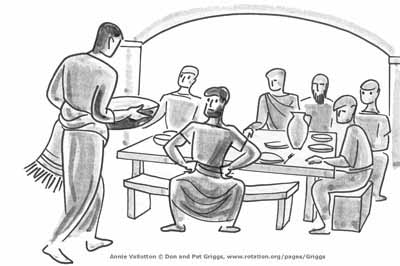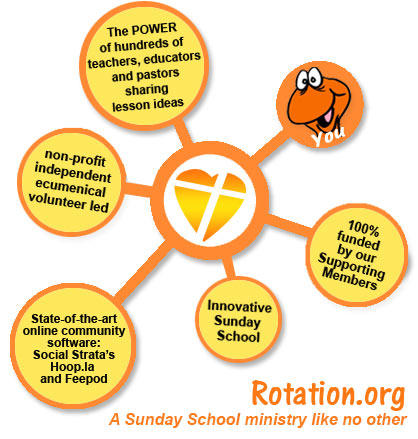The Last Supper
Cooking/Storytelling Workshop
Summary of Lesson Activities:
As the story of the Last Supper is spoken, students will be given various foods to taste and eat -- to help them focus and remember.
Supply List:
- Baggies
- Pretzels
- a dish of Salt water and a dish of honey
- Dates
- Unleavened Cracker (Matzoh crackers can be found in the grocery store)
- Grapes
- Liquorice string
Lesson Plan
Opening
Greet the children and introduce yourself. Tell them what they will be doing and what you hope they will learn today.
Eating Our Way Through the Story
As you tell and discuss the story, you'll present various foods for students to taste and eat.
The first Sunday of Holy week was a joyful one! Jerusalem was crowded because many people had come from all over to celebrate Passover. This springtime celebration reminded the Jewish people that God helped their ancestors escape from slavery in Egypt. Everybody came to Jerusalem to celebrate Passover because the Jewish Temple was in Jerusalem.
Let's start the story with this pretzel that looks like a walking stick to remind us of how the Jews escaped out of Egypt and about how the Jews travelled to the temple for Passover each year.Guess who also came to Jerusalem? (Hopefully kids will say JESUS!)
Take a bite of pretzel to remember that Jesus is the Bread of Heaven -- the one sent by God to save us.
He knew that this Passover would be very different that all the others.
People packed the streets. Suddenly someone cried, “Look at that man riding the little Donkey! Who is that? (Ask kids, again answer is JESUS!)
Yes it’s the one who heals the sick and rises the dead!” The one who turns tears into joy!
Taste the salt on your pretzel to remember Jesus comes to wipe our tears.
Dip your pretzel in honey to remember that Jesus comes to bring us true happiness -- knowing and following him.
The people were so happy to see Jesus coming they took off their coats and laid them on the road for him to ride over. “Hosanna, hosanna”, they shouted.
Others tore palm branches from the trees and waved them joyfully. People remembered that God had promised to send a Messiah to help them. They knew that the messiah would be a descendant of King David. The shouts grew louder: “Hosanna to the Son of David! Blessed is the one who comes in the name of the Lord! Hosanna in the highest Heaven!”
Those palm branches they were waving may have been date palms so lets try some dates.
Take a bite of date. Is it sweet or sour? What does it say about the arrival of our king?
Palm Sunday was a great day but even then people were planning bad things to do to Jesus.
Tension grew with each passing day. Thursday near sundown, Jesus and his friends entered a borrowed house. Here they ate the Passover meal together. Jesus served as head of the family, offering blessing over special foods.
Their food included unleavened bread. This bread reminded the Jews that their ancestors had escaped Egypt so quickly that there was no time to make normal bread.
Lets try a piece of unleavened cracker (Carrs Table water crackers or bread, pita etc.)
Take a bit of unleavened cracker. Does it seem "finished" to you? How does it remind us of the FIRST Passover when the people left Egypt hastily?
What is the unleavened bread missing? It's missing "air." Interestingly, the word for "spirit" as in "Holy Spirit" is the word for "wind" in Hebrew. ("Ruach") We are "flat and dry" too if we are missing God's Holy Spirit in our lives.
During the Last Supper, Jesus raised several "cups of blessing" to honor and praise God. What kind of things do you think Jesus said about God?
What is wine made out of ? Grapes!
Let's eat the Grapes. Do they taste harsh or good? What does their taste tell you about God?
During this last supper Jesus told the disciples that one of them would betray him. Everyone at the table was upset. Each said “Surely not I “ Who do you think it was? (JUDAS!) Yes even Judas who had already promised to lead Jesus’ enemies to him said, “Surely not I Rabbi.”
Jesus was very sad about this betrayal and knew that he was going to be handed over to his enemies. What do you when you are in trouble and no one can help you? (Take all comments , hopefully prayer will be mentioned!)
Jesus went to a Garden to pray for strength to be able to do what God wanted him to do. Jesus did not want to make that journey to the cross, but he was willing to do what God needed him to do.
If we look at the shape of this pretzel we see arms folded in prayer. Jesus prayed long and hard that night. Eat that too.
Suddenly a large crowd came out of the darkness. There was Judas leading them. The crowd rushed forward and arrested Jesus.
Early on Friday morning, Jesus was taken and judged before the Jewish leaders , priests and Roman authorities. They sentenced him to be crucified. On the cross, above his head, they wrote the charge against him: “This is Jesus, the King of the Jews.”
When Jesus died on the cross, they buried his body in a tomb and sealed it with a large stone. But is that the end of the story? Did Jesus STAY dead? No, God raised Jesus from the dead as a sign that God's will cannot be beaten, that God is in charge, and everything Jesus said was true -- that we ARE loved by God and God wants us to be with him both on earth and in heaven.
Take some licorice. Eat some but tie a length of it around your finger to REMEMBER the story and words of Jesus. Place some in your baggie to share with someone else.)
Closing
Share more food, including some bread and juice as you reflect on the story. Quiz them about what each food item represented/told them about Jesus and the story.
Close with prayer. Invite students to make a "take home" pack of foods they shared.
A lesson written by Engel and enhanced by the Rotation.org Content Team

 This forum is part of Rotation.org's
This forum is part of Rotation.org's 

